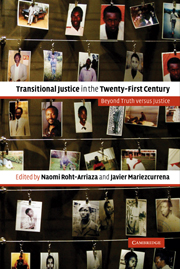Book contents
- Frontmatter
- Contents
- List of contributors
- Acknowledgments
- The new landscape of transitional justice
- Part I Truth, justice, and multiple institutions
- Part II Levels of justice: Local, national and international
- Introduction to Part II
- 7 A new approach to restorative justice – East Timor's Community Reconciliation Processes
- 8 Justice at the grassroots? Gacaca trials in Rwanda
- 9 Bremer's “Gordian Knot”: Transitional justice and the US occupation of Iraq
- 10 Truth, justice and stability in Afghanistan
- 11 The prosecution of Hissène Habré: International accountability, national impunity
- 12 Argentina's contribution to global trends in transitional justice
- 13 Transitional justice: Lessons learned and the road ahead
- Index
8 - Justice at the grassroots? Gacaca trials in Rwanda
Published online by Cambridge University Press: 05 June 2012
- Frontmatter
- Contents
- List of contributors
- Acknowledgments
- The new landscape of transitional justice
- Part I Truth, justice, and multiple institutions
- Part II Levels of justice: Local, national and international
- Introduction to Part II
- 7 A new approach to restorative justice – East Timor's Community Reconciliation Processes
- 8 Justice at the grassroots? Gacaca trials in Rwanda
- 9 Bremer's “Gordian Knot”: Transitional justice and the US occupation of Iraq
- 10 Truth, justice and stability in Afghanistan
- 11 The prosecution of Hissène Habré: International accountability, national impunity
- 12 Argentina's contribution to global trends in transitional justice
- 13 Transitional justice: Lessons learned and the road ahead
- Index
Summary
On April 6, 1994, a plane carrying the presidents of Rwanda and Burundi was shot down as it approached the airport in the Rwandan capital, Kigali, killing all on board. The assassination of President Juvénal Habyarimana served as a pretext for launching a long-planned program to eliminate political rivals to the president and his supporters. Violence was initially focused in the capital, as the presidential guard and other elite troops targeted opposition politicians and civil society activists of all ethnicities. As the group of military and political leaders who assumed control of Rwanda carried the violence into every corner of the country, however, it quickly assumed the clear characteristics of genocide, since it focused on Rwanda's minority ethnic group, the Tutsi, regardless of their political activity, class, age, or gender. By the time the rebel Rwandan Patriotic Front (RPF) took control of the country in mid-July 1994, more than half a million people had been killed.
In the decade since the 1994 genocide and war, the government of Rwanda has undertaken a variety of programs to attempt to promote reconciliation, combat impunity, and prevent future communal violence. The government has built numerous memorials and established annual commemorations of the genocide, sought to create unity by adopting a new national anthem, flag, and seal, overseen the drafting of a new constitution and various political reforms, and instituted programs, including “solidarity camps” for students, former prisoners, and returned refugees to teach a revised history of the country.
- Type
- Chapter
- Information
- Transitional Justice in the Twenty-First CenturyBeyond Truth versus Justice, pp. 206 - 228Publisher: Cambridge University PressPrint publication year: 2006
- 16
- Cited by



